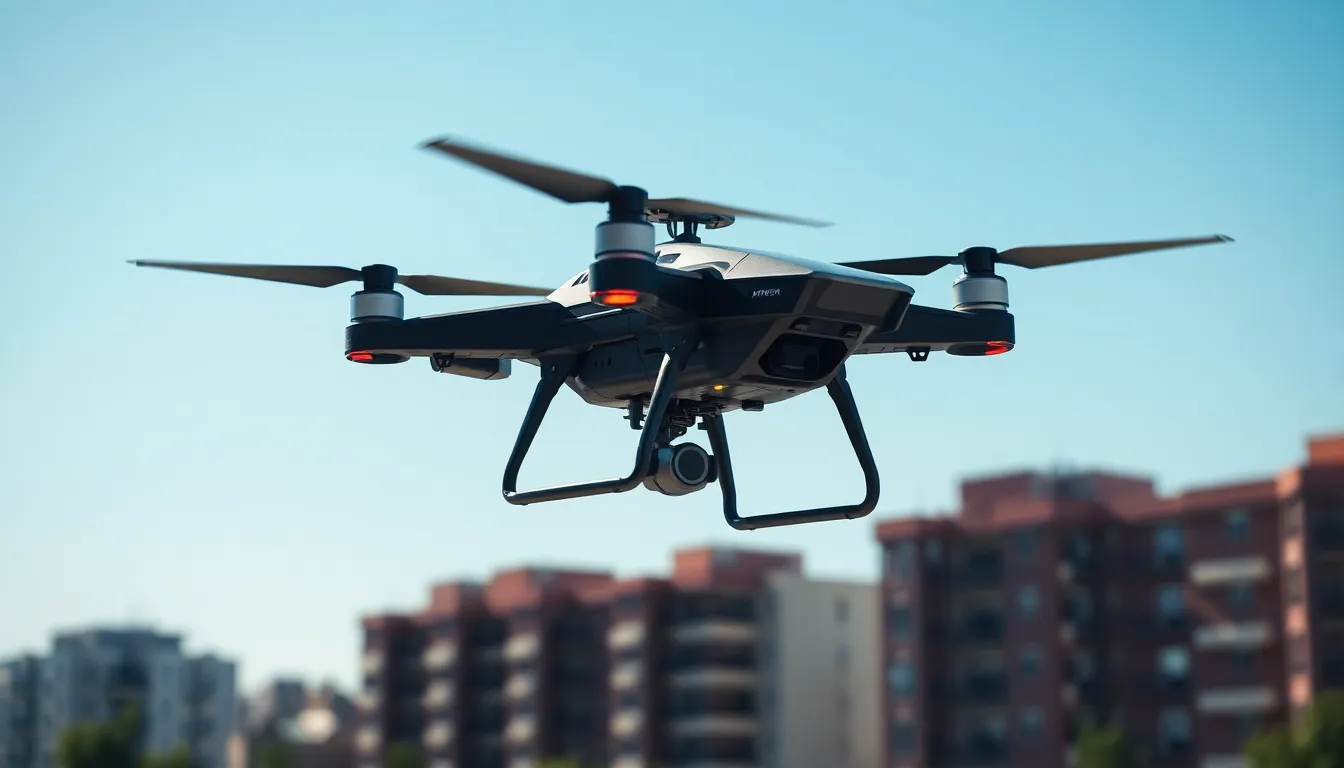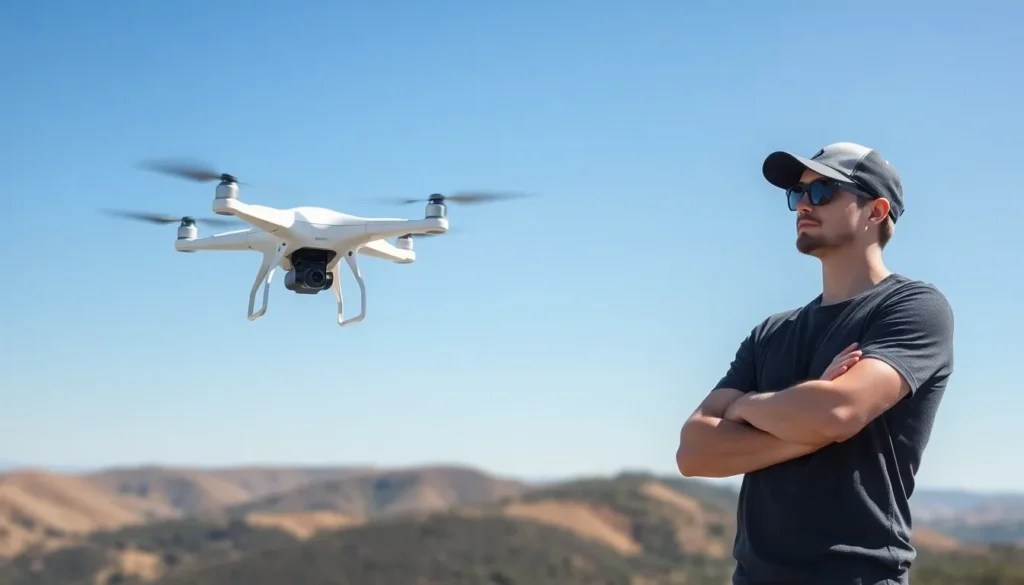In a world where the sky’s the limit, helicopter drones are swooping in to change the game. These flying marvels combine the agility of a helicopter with the tech-savvy prowess of drones, making them the ultimate aerial multitaskers. Whether it’s capturing breathtaking footage or delivering pizza (yes, really), these gadgets are redefining how we think about flight.
Table of Contents
ToggleOverview of Helicopter Drones
Helicopter drones combine the agility of traditional helicopters with the modern advancements of drone technology. These flying devices serve various purposes across industries, showcasing their adaptability and efficiency.
Manned and unmanned helicopter drones allow for enhanced aerial operations. For instance, they excel in tasks including aerial photography, surveillance, and cargo delivery. Applications range from capturing stunning landscapes to monitoring wildlife.
Flight durations typically extend beyond traditional drones, offering up to 30 minutes of continuous operation, depending on the model and battery capacity. Weighing between 5 to 40 pounds, they carry diverse payloads, making them suitable for different tasks.
Capabilities include sophisticated stabilization systems, allowing for smooth operation in windy conditions. Users employ high-definition cameras for clear imagery and real-time data collection, enhancing decision-making processes.
Features often include GPS-guided navigation, promoting precise flight paths and accurate positioning. Some helicopter drones even integrate obstacle avoidance systems, enhancing safety during operation.
Emerging developments in helicopter drone technology focus on improving battery life and range. As these innovations unfold, potential applications may expand further, pushing the boundaries of aerial capabilities across various sectors.
Key Features of Helicopter Drones

Helicopter drones offer a blend of agility, efficiency, and advanced technology. Their unique features contribute to their effectiveness across numerous applications.
Flight Performance
Flight performance determines how well helicopter drones operate under various conditions. Many models achieve flight times exceeding 30 minutes. These drones excel in maneuverability, enabling them to navigate tight spaces with ease. Wind resistance is often managed through advanced stabilization systems, ensuring smooth operation even during adverse weather. High-speed capabilities allow for rapid response in critical scenarios, such as surveillance and search missions. Enhanced GPS navigation systems contribute to precise flight paths, allowing users to trace designated routes confidently.
Payload Capacity
Payload capacity plays a crucial role in the versatility of helicopter drones. Many models can carry loads ranging from 5 to 40 pounds, making them suitable for diverse tasks. This flexibility facilitates applications in aerial photography, delivery services, and surveillance operations. Advanced designs allow for secure attachment of various payloads, ensuring stability during transport. The combination of capacity and flight performance enables operators to manage larger items, such as medical supplies or equipment, without compromising efficiency. As technology progresses, improvements in lightweight materials further enhance payload capabilities.
Applications of Helicopter Drones
Helicopter drones offer diverse applications, enhancing operations across multiple sectors. Their unique features and capabilities make them invaluable in various fields.
Search and Rescue Operations
Search and rescue operations benefit significantly from helicopter drones. These devices allow teams to cover vast terrains quickly and efficiently. Equipped with thermal imaging cameras, they can detect heat signatures, aiding in locating individuals in distress. With precise GPS technology, helicopter drones navigate challenging environments seamlessly, even in low visibility. Rapid aerial reconnaissance helps responders assess situations and coordinate rescue efforts effectively. Additionally, their ability to transport medical supplies drastically improves emergency response times.
Agricultural Monitoring
Agricultural monitoring has transformed with the introduction of helicopter drones. Farmers utilize these drones for crop health assessments and resource management. High-resolution cameras facilitate detailed imaging of fields, helping identify plant stress and pest infestations early on. Enhanced data collection enables farmers to optimize irrigation and fertilization practices, increasing yield efficiency. Regular aerial surveys track crop growth over time, providing insights for future planting strategies. As a result, helicopter drones emerge as essential tools in modern farming, supporting sustainable agriculture.
Benefits of Using Helicopter Drones
Helicopter drones offer numerous advantages across various sectors. Enhanced maneuverability distinguishes them from traditional drones, allowing access to challenging environments, such as urban landscapes or remote areas. These devices excel in aerial photography and surveillance, capturing stunning visuals and providing crucial data.
In delivery applications, helicopter drones reduce transit times significantly. Capable of carrying payloads from 5 to 40 pounds, they can deliver essential items quickly and efficiently. Many commercial enterprises benefit from this technology, enhancing customer satisfaction through faster service.
Advanced stabilization systems help maintain smooth flight during windy conditions. They ensure reliable operation for tasks that require precision and stability. High-definition cameras integrated into helicopter drones provide clear imagery, improving data collection for surveillance and monitoring purposes.
GPS-guided navigation systems facilitate accurate flight paths, reducing the likelihood of errors. They allow operators to plan flights with remarkable precision, benefiting search and rescue missions as well. Equipped with thermal imaging capabilities, these drones assist teams in detecting heat signatures, significantly improving emergency response efficiency.
Agriculture also gains from utilizing helicopter drones. Farmers can monitor crop health by leveraging high-resolution imaging to identify plant stress, guiding resource management decisions. This approach supports sustainable farming practices, promoting environmental stewardship.
Emerging technologies continuously enhance helicopter drone capabilities. Innovations focus on battery life and range, expanding operational applications. Lightweight materials in production improve efficiency, enhancing both performance and versatility. In summary, helicopter drones represent a versatile solution, transforming various industries while maximizing effectiveness.
Challenges and Limitations
Factors influencing the performance of helicopter drones include battery life and payload limitations. Many models achieve flight times of up to 30 minutes, yet longer missions require improved battery technology. Payload capacities range from 5 to 40 pounds, which constrains the types of equipment and supplies they can transport.
Weather conditions pose another significant challenge. Helicopter drones, despite advanced stabilization systems, may struggle during heavy winds or adverse weather, limiting their operational effectiveness. High-definition cameras and obstacle avoidance systems enhance flight safety but might not completely negate the risks associated with turbulent environments.
Regulatory hurdles also affect helicopter drone usage. Government regulations surrounding airspace restrictions and drone operation have specific mandates that operators must follow. Compliance with these regulations can complicate deployment in certain zones, particularly in urban environments.
Cost remains a factor for businesses considering adopting helicopter drones. Advanced technology integrates sophisticated features but comes with a higher price tag. Smaller companies might find it challenging to justify the investment compared to traditional aerial methods.
Technical expertise is essential for optimal operation. Many helicopter drones require skilled operators who understand flight systems and navigation technologies. Lack of trained personnel can hinder the effectiveness of these devices, making it vital for organizations to invest in training programs.
Lastly, public perception and privacy concerns continue to impact the broader acceptance of helicopter drones. Community apprehension surrounding surveillance capabilities may influence their deployment in sensitive areas. As technology evolves, addressing these challenges will be crucial for expanding the application of helicopter drones across various sectors.
Helicopter drones are revolutionizing the way industries operate by combining advanced technology with impressive maneuverability. Their ability to perform a variety of tasks—from delivering goods to conducting aerial surveys—demonstrates their growing importance in modern applications.
As these drones continue to evolve, improvements in battery life and payload capacity will likely expand their reach even further. While challenges such as regulatory hurdles and public perception remain, the potential benefits of helicopter drones are undeniable.
By addressing these issues, they can become indispensable tools in sectors ranging from agriculture to emergency response, ultimately enhancing efficiency and effectiveness in various operations. The future of helicopter drones looks promising, paving the way for innovative solutions that redefine aerial capabilities.

